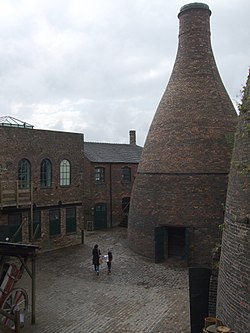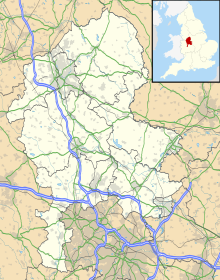Gladstone Pottery Museum

The courtyard and bottle kiln
|
|
| Established | 1974 |
|---|---|
| Location | Longton, Staffordshire, England |
| Coordinates | 52°59′12″N 2°07′53″W / 52.98667°N 2.131488°W |
| Type | Industrial museum |
| Public transit access | Longton railway station 10 mins by foot |
| Website | http://www.stokemuseums.org.uk/visit/gpm/ |
The Gladstone Pottery Museum is a working museum of a medium-sized coal-fired pottery, typical of those once common in the North Staffordshire area of England from the time of the industrial revolution in the 18th century to the mid 20th century. It is a grade II* listed building.
The museum is located in Longton, Stoke-on-Trent, Staffordshire. It is also included in one of the regional routes of the European Route of Industrial Heritage. Despite the name of the museum, it is a complex of buildings from two works, the Gladstone and the Roslyn. The protected features include the kilns. As there are less than 50 surviving bottle ovens in Stoke-on-Trent (and only a scattering elsewhere in the UK), the museum's kilns along with others in the Longton conservation area represent a significant proportion of the national stock of the structures.
A pottery factory first opened on the site in 1787. It was run by the Shelley family who produced earthenware and decorated plates and dishes produced by Josiah Wedgwood in Etruria. The site was purchased in 1789 by William Ward who split it into two pot banks: the Park Place Works subsequently named the Roslyn works, and the Wards Pot Bank which was sold to John Hendley Sheridan in 1818.In the 1850s Sheridan had rented out the site to Thomas Cooper who employed 41 adults and 26 children to produce china and parian figures.
By 1876 the Wards site had passed into the hands of R Hobson and Co and had been renamed Gladstone, after the politician William Ewart Gladstone.
The factory opened as a museum in 1974, the buildings having been saved from demolition in 1970 when the pottery closed (some ten years after its bottle ovens were last fired). In the 1990s ownership passed to Stoke-on-Trent City Council. The museum has shown its commitment to industrial heritage by functioning as a working pottery. However, production has had to be curtailed for financial reasons and the museum is therefore less of a "living" museum than it was. As at 2014 the Middleport Pottery in Burslem, which is used for commercial production, is arguably the only working Victorian pottery in the city of Stoke-on-Trent.
...
Wikipedia

